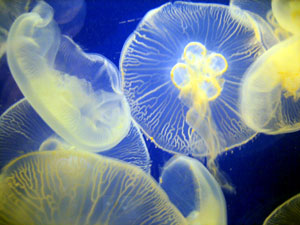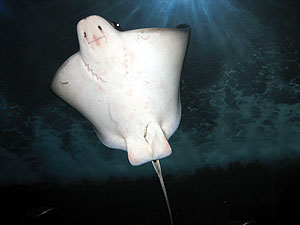In my last post, I wrote about a recent visit to the Aquarium of the Bay at PIER 39 and a couple of the fascinating creatures we encountered there. Here are a few more:
 Drifting in slow motion are the otherworldly moon jellies. Found in temperate and tropical waters around the world, they like bays and are found in San Francisco Bay (though they may not be native). You may know a Bay swimmer who has had the experience of encountering one; most humans can't feel their sting, but it is said to be a strange sensation to feel one scoot from your touch. And here's an interesting factoid: They haven't been to the moon, but in 1991 nearly 2,500 juvenile moon jellies flew aboard the space shuttle Columbia.
Drifting in slow motion are the otherworldly moon jellies. Found in temperate and tropical waters around the world, they like bays and are found in San Francisco Bay (though they may not be native). You may know a Bay swimmer who has had the experience of encountering one; most humans can't feel their sting, but it is said to be a strange sensation to feel one scoot from your touch. And here's an interesting factoid: They haven't been to the moon, but in 1991 nearly 2,500 juvenile moon jellies flew aboard the space shuttle Columbia.
 We enter a second underwater tunnel beneath a tank home to several of the Bay's cartilaginous fish (rays, skates, and sharks, who lack the bony skeletons of other fish). We look up to see graceful bat rays "flying" over our heads. There are also seven-gill sharks, whose name gives away their distinctive feature (most sharks have five gills). We also see leopard sharks, with beautiful charcoal markings that help them disappear in the mottled light of their preferred habitat: shallow waters with sandy or muddy bottoms, where they feed on worms, mollusks, crustaceans, and small fish. Unlike some sharks, they don't need to swim to breath, and several that we saw in the Aquarium were resting on the bottom, pumping water over their gills with their lower jaw.
We enter a second underwater tunnel beneath a tank home to several of the Bay's cartilaginous fish (rays, skates, and sharks, who lack the bony skeletons of other fish). We look up to see graceful bat rays "flying" over our heads. There are also seven-gill sharks, whose name gives away their distinctive feature (most sharks have five gills). We also see leopard sharks, with beautiful charcoal markings that help them disappear in the mottled light of their preferred habitat: shallow waters with sandy or muddy bottoms, where they feed on worms, mollusks, crustaceans, and small fish. Unlike some sharks, they don't need to swim to breath, and several that we saw in the Aquarium were resting on the bottom, pumping water over their gills with their lower jaw.
One of the oddest fish we spot is the white sturgeon, an ancient-looking creature that has bony, armor-like plates called scutes instead of scales. They can grow to 20 feet and 1,500 pounds and are the largest anadromous fish in North America (meaning they migrate between salt and fresh water, where they spawn). Their Latin name, Acipenser transmontanus, means "sturgeon beyond the mountains". Their greatest predators are humans, for whom they are a popular sport fish and source of caviar.
In the final part of the tour we get a chance to reach into the water and touch sea stars, sea squirts, and other creatures. It's like shaking hands with next-door neighbors we never get to see. And that's perhaps the most amazing thing: All these animals that seem so alien actually live close by. So next time you're admiring the beautiful expanse of the Bay or the nearby ocean, take a moment to think about all the life underneath, all the aquatic species in our Bay Area "neighborhood". You might even decide to drop into the Aquarium of the Bay and make their acquaintance.
